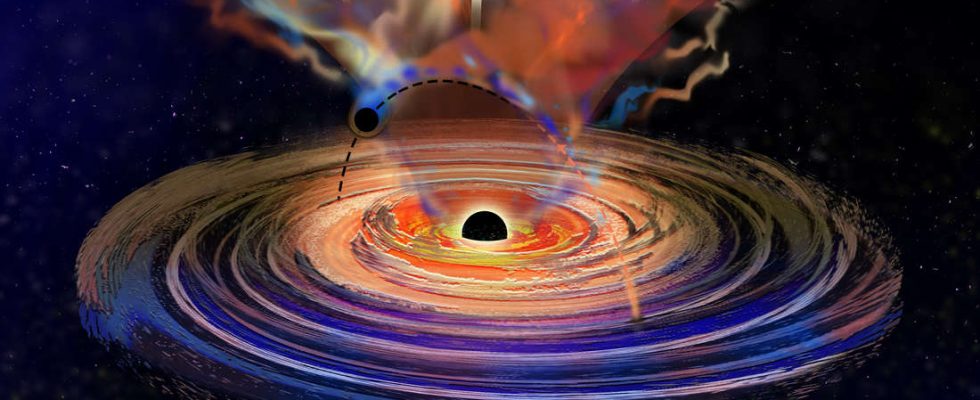Press
A black hole behaves extremely unusually, attracting the attention of a research team. This finds a surprising answer.
Boston – Black holes are mysterious celestial bodies. Their incredibly strong gravity attracts everything that comes too close to them and doesn’t let anything out. Not even light can escape a black hole – which is why you can’t see the mysterious objects. Only with the help of tricks was a collaboration of researchers and telescopes able to photograph the shadows of two black holes – most recently in polarized light that revealed strong magnetic fields at the center of our Milky Way.
Another research team has now discovered a black hole that behaves extremely strangely. The object, located at the center of a galaxy about 800 million light-years away, had “hiccups,” one said notice. It suddenly erupted and emitted clouds of gas every 8.5 days before calming down again. Research knows a lot about black holes – but the fact that a black hole has “hiccups” is still unknown. What could be behind it?
Black hole has “hiccups” – researchers claim to have found an explanation
In a study that in the specialist journal Science Advances published the research team describes its results. It is therefore most likely that the regular outbursts were triggered by a second, smaller black hole that “buzzes” around the central supermassive black hole. Every 8.5 days, this smaller object is expected to eject material from the accretion disk surrounding the large black hole.
What is an accretion disk?
In astrophysics, an accretion disk is a disk of gas that rotates around an object and transports matter toward the center. In the case of a black hole, the matter that “feeds” the black hole is contained within it.
Stars can also be surrounded by accretion disks in which planets form over time.
“We thought we knew a lot about black holes”
A black hole located in the accretion disk of another black hole – this new idea challenges the previous image of black hole accretion disks. Until now, researchers have assumed that these are relatively uniform disks of gas rotating around a black hole. But the new research shows that accretion disks could potentially contain other black holes or even entire stars.
“We thought we knew a lot about black holes, but this shows us that there are many more things they can do,” says study author Dheeraj Pasham of the Massachusetts Institute for Technology (MIT). “We believe there will be many more systems like this. We just need to collect more data to find them.”
Black hole makes its host galaxy become significantly brighter
The “hiccup” black hole was originally discovered by the automated ASAS-SN telescope network in December 2020, just as it was undergoing an outburst that made its host galaxy significantly brighter. Pasham discovered the galaxy and soon realized that the amount of energy emitted had an 8.5-day rhythm. “I was racking my brain about what this meant, because this pattern doesn’t fit anything we know about these systems,” Pasham recalls.
The researcher brought in other experts and observed the strange behavior of the black hole. It turns out that the galaxy it is in was relatively quiet before December 2020. This month, a third object – possibly a star – must have gotten too close to the black hole. The object was torn apart by the black hole’s gravity – a process astronomers call “spaghettification”. The material from the torn star ended up in the accretion disk, causing it to shine brighter.
Black hole devours star – and is orbited by a smaller black hole
According to the researchers, the black hole devoured the stellar remnants for four months, while the second, smaller black hole moved regularly through the accretion disk, ensuring the observed 8.5-day rhythm. Using simulations, the research team tested this theory and concluded that it must be a new type of David and Goliath system – a tiny, intermediate-mass black hole orbiting a supermassive black hole.
“This is a whole different beast,” says Pasham. “It doesn’t fit everything we know about these systems. We see signs of objects entering and passing through the disk at different angles, challenging the traditional picture of a simple gaseous disk around black holes.” The researcher adds: “We think there is one out there there is a huge population of these systems.” (tab)

